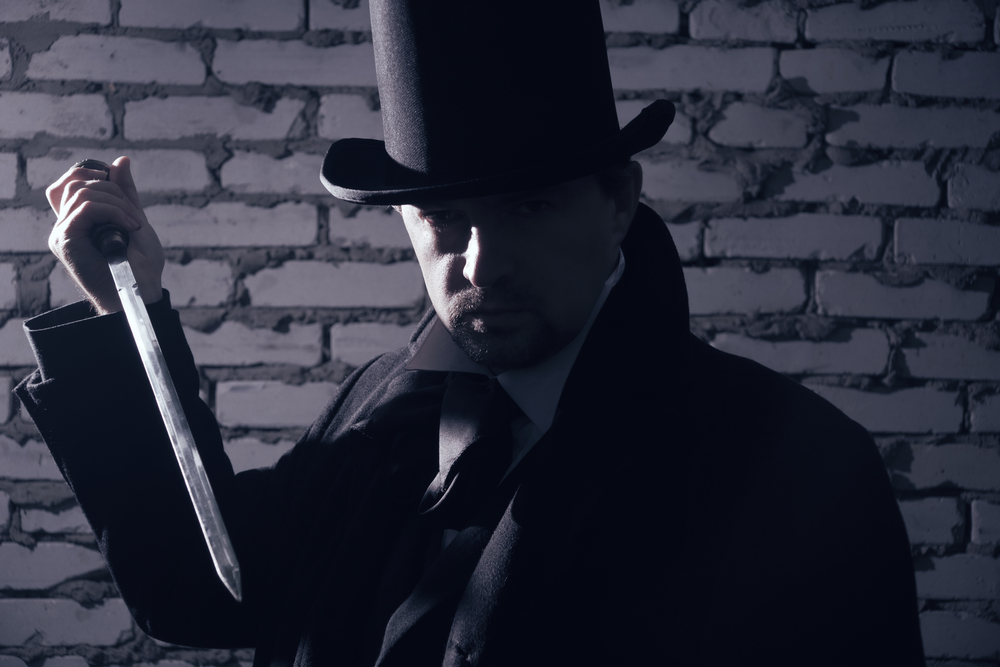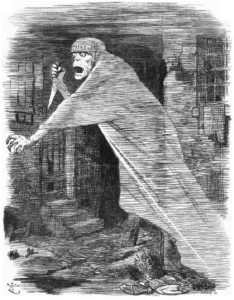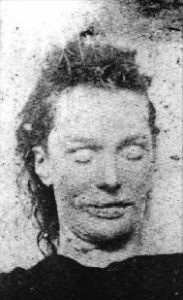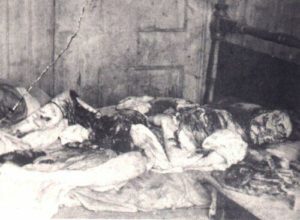Just how many victims did Jack the Ripper have? The number of canonical victims is five, but some people say there are more, and some less. What measuring sticks do Ripperologists use to figure their lists?
Historian and true crime aficionado Cal Schoonover joins us today with a guest post containing his analysis of the primary sources. What do you think? Please comment below.
Welcome, Cal Schoonover!

Lizenzfreie Stockfotonummer: 514093975; with permission.
Whitechapel 1888: The reign of Jack the Ripper begins
The violence London saw during the autumn of 1888 was something out of a horror novel. Murder was nothing new for the people in the East End, but the horrific way a group of murders occurred starting in April of that year caught the attention of many who lived there. The people of London’s East End in the district of Whitechapel faced poverty beyond what others in London faced. The slaughter houses employed people on a day-to-day basis as well as dock labors. Work was not a guarantee and when it ran out, people did what they had to do to survive. They stole and they prostituted themselves.
Violence was the norm, so to say, so when people’s attention was caught by the Whitechapel killer, forever known as Jack the Ripper, the crimes had to have been bad. On the morning of Friday, August 31, 1888 a carman named Charles Cross was on his way to work “about half past three” in the morning. Cross walked down the dark secluded street of Bucks Row when he spotted something that resembled a tarpaulin in the street. Moving closer, Cross could see it was not a tarpaulin, but the body of Mary Ann “Polly” Nichols.
Canonical victim 1: Polly Nichols
Another carman named Robert Paul, who was also on his way to work when he came upon the scene. “Come and look over here; there is a woman lying on the pavement,” Charles Cross said.[1] Moving in for a closer look, both men gazed down at the woman. Not seeing any blood and pressed for time, both men left the scene in hopes of finding a policeman.
Not long after Cross and Paul left did the first policeman arrive. It was Police Constable (PC) John Neil, who was walking his normal beat. Seeing the outline of a person on the ground, Neil shined his bull’s-eye lantern on the figure. She was “lying on her back, with her clothes disarranged” with “blood oozing from a wound in the throat.”[2] Neil called for help and asked an arriving policeman to fetch a doctor. After they pronounced her dead, they removed the body from the scene and taken to the mortuary, where upon further examination, it was discovered severe abdominal mutilation had occurred. A bruise in the shape of a thumb was found on the lower right jaw and on the left cheek. The wound in the neck was noted to be jagged, proving the neck was cut at least twice down to the spine. There was no sign of a struggle either, which indicates Nichol’s willingly went with her killer.

Canonical victim 2: Annie Chapman
Annie Chapman, the second victim, was found on the morning of September 8, 1888 in the backyard of 29 Hanbury Street. Chapman was a forty-seven-year-old prostitute whose life was just as hard as the others in her line of work. She spent the last night of her life drinking and searching for clients who were willing to pay her a few pennies for sexual favors.
Her body was found by a resident of 29 Hanbury Street, John Davis, who was horrified at his discovery. Davis didn’t examine the body; he just turned around after seeing it and ran for help. Inspector Joseph Chandler testified at Chapman’s inquest that he observed Chapman lying on her back with her legs drawn up. “A portion of the intestines, still connected with the body, were lying above the right shoulder,” Chandler described.[3] He sent for Dr. George Bagster Phillips, the divisional police surgeon.
Phillips examined the body, noting the throat had been severed deeply by a jagged cut along with bruises the size of a man’s thumb. Along with considerable abdominal mutilation, identical to the injuries Nichol’s received. Dr. Phillips noted the killer may have possessed some anatomical knowledge, having removed Chapman’s uterus intact. The killer would have to know what to look for and where exactly to cut without damaging the organ. The killer, according to Phillips, displayed this skill.
Canonical victims 3 and 4: The double event
Victim 3: Elizabeth Stride

On September 30, 1888 the famous “double event” took place. The first killing of the night took place at Dutfield’s Yard, Berner Street shortly before 1:00 a.m. The victim was forty-four- year old Elizabeth Stride. Stride, like the other victims, was a known prostitute, but unlike the others, she was not mutilated.
Louis Diemschutz drove his pony and cart down the dark alley way into Dutfield’s yard, tired after a long day of peddling his trinkets. He could see the gates were wide open on the other end of the alley way, but as he neared the open gates, his pony shied away and wouldn’t move. There was an “object” lying in his path, but unable to make out what the object was, he jumped off his cart and lit a match. The wind picked up, blowing his match out, but he was able to see “it was the figure of a woman.”[4] Frightened, he ran for help, shouting “police” as he entered a nearby club.
Elizabeth Stride was lying on her back with her right arm over her stomach and her left arm extended from the elbow. In her hand she was clutching a packet of cachous, a breath sweetener. Stride wore a silk scarf around her neck, which was pulled tight as if she had been strangled by it. The lower part of the scarf was frayed, obviously from the deep cut to the throat she received. Blood flowed from the neck and onto the sidewalk; there were no other mutilations to Stride.
Another explanation?
Some people argue that Stride was not mutilated because Diemschutz interrupted her killer. While this is a possibility, the more likely scenario is that Stride was killed due to a domestic dispute. While people may or may not agree with the argument presented here, it is important to keep an open mind about how things were in the poverty stricken East end.
On the night Stride was murdered, an eye witness named Israel Schwartz saw a man grab and throw Stride to the ground. There was a second well -dressed man who was within feet of this attack standing there lighting his pipe. When the one man threw Stride to the ground, the well- dressed man ran off. Schwartz told police he was not sure if the two men were together or not. The man who threw Stride to the ground was described as 5ft. 5in. tall, with dark hair and a small brown moustache. He was broad shouldered and wore a dark -jacket and trousers along with a black peaked cap. The other man was taller and wore a dark dress over coat, with a black hard felt hat and carried a pipe.
Michael Kidney as a suspect
The more likely answer is the better dressed man was Stride’s client. Her attacker fits the description of her long-time boyfriend Michael Kidney, known by police to be violent and abusive to Stride. Kidney and Stride had lived together for three years by the time she was murdered and according to Kidney, the two lived together “nearly all that time.”[5] Kidney told the inquest that Stride had left him for at least five months total out of those three years due to his violent acts. He last saw Stride on September 25 and expected her home later that night. Catherine Lane, however, was called as a witness at the Stride Inquest and stated Stride left Kidney after a fight. Kidney denied this, but he did admit Stride had left him in the past. The stormy relationship they had included violence..
If the man in the peaked hat had approached Stride and the well-dressed man with the intent of robbing or murdering her, why didn’t Stride put up a fight or scream for help? Maybe because Stride knew her attacker, knew that she would be yelled at and possibly hit but not murdered. As she was shoved to the ground, her client fled, her killer then slit her throat while Stride was on the ground. The fact Stride still clutched the packet of Cachous in her hand proves she did not attempt to defend herself. Why?
So how exactly had Kidney known his ex-girlfriend had been murdered?
One last interesting fact is the day after Stride’s murder, Kidney, in a drunken rage stormed into the Leman Street Police Station in Whitechapel demanding to see a detective. He was thrown out of the station but claimed he had information about the murder. The problem with this is at the beginning of Stride’s inquest, she was identified as Elizabeth Stokes, not Stride. So how exactly had Kidney known his ex-girlfriend had been murdered? Kidney admitted he went to the police station to complain about her death, yet no one knew Stride was even dead at this time.
The murder of Elizabeth Stride gives the impression of a domestic dispute. However, due to the location and of past events, the hype of the Ripper murders linked Stride to the list of Jack the Ripper’s victims. The fact that Stride was murdered on the same night the actual Ripper chose to murder is a coincidence.
Victim 4: Catherine Eddowes
Not long after Stride was found murdered, forty-six-year-old Catherine Eddowes was released from the Bishopsgates Police Station. She had been arrested for being drunk in public and not answering a policeman’s questions. She was also a known prostitute. Eddowes was released around 1:00 a.m. and was last seen walking in the direction of Mitre Square. By 1:30 a.m. PC Watkins had passed through the square and nothing was out of the ordinary. When he reentered the square around 1:45, he found the body of Catherine Eddowes. Her body had been ripped open, it was a sight that Watkins had never seen before. Eddowes’s abdominal area had been completely ripped open, her intestines were ripped out and placed over her right shoulder. The throat had also been cut along with some small cuts to the face. Much of Eddowes’s nose was also cut off as well as her earlobe and her eyelids were slit.
Further examination of Eddowes’s body showed her right kidney had been cut out and taken away. Like in the case of Annie Chapman, Eddowes’s uterus was taken away by her killer. This frenzied attack on Eddowes happened in less than fifteen minutes and not one person heard any unusual sounds. The Ripper once again escaped undetected.

Canonical victim 5: Mary Kelly
The last murder that has been attributed to Jack the Ripper was a younger woman named Mary Jane Kelly. She was different than the other victims. Not only was she much younger, but she also had her own lodgings. It was at her lodging house that her severely mutilated body was found. Mary Kelly, while considered to be Jack’s last, raises the question of whether she was an actual Ripper victim. Much like Stride, Kelly had worked as a prostitute, but she also had a live-in boyfriend named Joseph Barnett who had “lived with the deceased one year and eight months.”[6]
Twenty-five-year-old Mary Jane Kelly rented a one room apartment at 13 Miller’s Court, 26 Dorset Street in Spitalfields. She was reportedly out drinking at the Ten Bells Pub earlier in the night and was heard singing in her room in the early morning hours of November 9, 1888. By 10:30 that morning, no one had seen or heard anything from Kelly. Her rent was past due, so her landlord, John McCarthy sent his employee, Thomas Bowyer over to collect.
A gruesome murder
Bowyer knocked several times but got no answer. “Receiving no reply, I passed around the corner by the gutter spout where there is a broken window – it is the smallest window,” Bowyer said.[7] The window had a broken pane, so Bowyer reached his hand through and pulled back the curtains. His blood ran cold at the horrific scene before his eyes. “I saw two pieces of flesh lying on the table,” he described to the inquest. “The second time I looked I saw a body on this bed, and blood on the floor.”[8]
He ran from the scene to tell his boss of his discovery. McCarthy, not believing what he heard, followed Bowyer back to the crime scene. Seeing the horrific sight for himself, he knew the police had to be contacted. Mary Jane Kelly had been completely mutilated beyond recognition. Her legs were cut down to the bone, her face was cut off. Her stomach had been completely ripped open and her heart was missing. Her breasts were cut off and placed under her head and the intestines were placed between her legs. Pieces of flesh the killer cut off were placed on the table next to the bed. Her throat also had been cut, which was enough to cause death.
Joseph Barnett as a suspect
While the murder of Mary Kelly was horrific and linked to Jack the Ripper, the question remains if she was his victim or not. Joseph Barnett moved out after an argument with Kelly on October 30. Kelly, according to Barnett, had allowed a woman of “bad character” stay with them and he “objected to it.”[9] Barnett told the inquest he last saw Kelly on Thursday, November 8 around 7:45 p.m. when he came to her room and visited for a while. She asked Barnett for money, but not having worked in a while, he had none to give.
Kelly’s murder screams personal attack, like perhaps from a jealous boyfriend.
During the inquest, Barnett admited Kelly and he quarreled often. He also said he would read the newspapers about the Ripper’s murders to Kelly, who was afraid of what was taking place on the streets. People assume Kelly’s murder is connected to Jack the Ripper simply because of the timing of events; much like in the case of Stride. However, Kelly’s murder screams personal attack, like perhaps from a jealous boyfriend. One can not dismiss Joseph Barnett as Kelly’s probable killer. Although questioned for four hours by Inspector Abberline and released, one must remember that during this era, unless a killer was caught in the act, a murder charge was hard to prove.
Barnett knew how to access Kelly’s room since he lived there. He knew how gruesome the murders were since he read about them in the newspaper and admitted to fighting with Kelly because of her life choices. Another interesting fact came to light during the inquest by a woman named Julia Vanturney, who claimed there was another Joe in Mary Kelly’s life. Vanturney testified that Barnett would “not allow her (Kelly) to go on the streets,” and she stated that Kelly “often got drunk.”[10] This shows how controlling Barnett was toward Kelly and Barnett admitted Kelly would drink a lot but not when he was around.
Barnett may have killed Kelly after another aggressive argument turned deadly. Knowing her death could possibly be blamed on the Ripper, he may have felt more confident that he could get away with her death. One must keep in mind that although he was questioned by police, the police were in-fact looking for someone who may have had anatomical knowledge. Barnett did not, so the police didn’t view him as a suspect.
Just three victims?
The name Jack the Ripper created sensational headlines for newspapers, which kept their readers wanting more. Hundreds of people came forward with false leads and information which caused more confusion. The police really had no idea where to begin and with limited ways and means, did the best they could to catch the killer who claimed three, not five victims. When looking at Modus Operandi, one can only truly name three victims killed by the same person. Stride and Kelly both died by the hand of another, but will forever be grouped into the famous five of none other than Jack the Ripper.
What do you think? Which victims should belong to Jack the Ripper’s list and why?
Thank you, Cal Schoonover!
About Cal Schoonover
Cal Schoonover holds a BA in 18th and 19th century Military History and is working on his MA in history with a concentration on the Civil War. He plans on pursuing his PhD by the fall of 2019. His articles have appeared in Crime Magazine, the Surratt Courier and Emerging Civil War. com. He lives in Wisconsin with his son James.

(c) By Cal Schoonover, 2018, with permission.
[1] Charles Cross testimony as published by The Daily Telegraph, Tuesday, September 4, 1888.
[2] PC. John Neil testimony as published by The Daily Telegraph, Monday, September 3, 1888.
[3] Inspector Joseph Chandler Inquest as published by The Daily Telegraph, Friday, September 14, 1888.
[4] Louis (Lewis) Diemschutz inquest testimony as published by The Daily telegraph, Tuesday, October 2, 1888.
[5] Michael Kidney’s testimony as published by The Daily Telegraph, Thursday, October 4, 1888.
[6] Joseph Barnett’s Inquest testimony as published by The Daily Telegraph, Tuesday, November 13, 1888.
[7] Thomas Bowyer’s Inquest testimony as reported by The Daily Telegraph, Tuesday, November 13, 1888.
[8] Ibid
[9] Barnett’s inquest testimony.
[10] Julia Vanturney’s inquest testimony as reported by The Daily Telegraph, Tuesday, November 13, 1888.




I have allways thought that Barnett was the most likely killer of Kelly not JTR. In fact I believe that JTR was allready dead when Kelly was murdered. It has been suggested that JTR received a cut injury when he disembowled Eddowes and this cut became infected by the contents of Eddowes intestines and without any antibiotics he died from that infection. Also Barnett was assisted by Hutchinson who’s statement in my view was just to good to be true.
That’s an interesting theory about the cut and the infection — one I haven’t heard before. If you have any evidence or sources to support it, I’d love to hear it. With respect to Kelly, Barnett certainly had motive and opportunity. My hesitation with him — my opinions differ from Cal Schoonover’s — has to do with the level of violence in the Kelly murder, suggesting a deranged killer. The scene lacks some of the hallmarks lover’s quarrel turned murder. Unless, as Cal suggests, Barnett was trying to imitate a Ripper murder to shift suspicion away from him.
That is a good theory about the Ripper dying from infection. My question against that though would be how could one know since we don’t know who he was?
As far as the Kelly murder is concerned, I’d agree the scene lacked the sense of a lovers quarrel. However, please be aware that Kelly was lying in bed, covered up when she was murdered, suggesting she was in a relaxed state when attacked. We know this because the sheet she used as a blanket was slashed by her killer’s knife.
Thanks for commenting, Cal. I hadn’t known Kelly was covered when she was murdered. That does seem to suggest she felt comfortable with whoever was in the room — or that someone broke in while she was sleeping.
You make a compelling case that there were three, rather than five JtR murders. I’ve never imagined that Stride was among the supposed ‘canonical five’. The more I read, the more I believe Kidney was responsible for Stride’s death and Barnett for Kelly’s. The question remains in my mind, could Barnett also have been responsible for other earlier deaths?
That’s a great question, Michael, and I’ll ask Cal to comment. Thanks for stopping by on my website!
Hi Michael,
Thanks for the question. There is so many different views on who the Ripper was and exactly how many did he kill. As described in my article, I do not believe in the famous five were all murdered by one person. The theory of the killer being interrupted as he murdered Stride is just something I do not think happened. Stride was, like many women who lived her lifestyle, in abusive relationships. Her murder points to a domestic case in my view. Mary Kelly’s murder points to the same as Stride. However, in my opinion, I do NOT believe that Barnett was the Ripper. Some of the people who knew Kelly, such as George Hutchinson saw Kelly enter her apartment with a man he did not recognize, but he should have known Barnett since Hutchinson claimed he knew Kelly for the past three years. While there is not rock hard proof that Barnett was not the Ripper, there is no proof he was either. The lack of evidence in the entire case against any suspect is difficult to prove. What motives did Barnett have to kill the other victims? There really is none, except to keep Kelly off the streets, but why would he risk being caught just to scare Kelly? His motive is strong for killing Kelly, but as far as the other victims goes, I personally just do not see it. That does not mean I am correct, but one would think if he was the Ripper, there would be a great possibility that Kelly would have known or at least had suspected him. After all, the Ripper was interfering with the way she conducted business. Although Kelly, like the other victims continued to accept clients, the fears among them would have been eased had the Ripper been captured and if Kelly felt her ex-boyfriend, Barnett was the killer, why not turn him in for the possible reward?
Well unlike many people, I am not very familiar with JTR. I know several people who know all the circumstances surrounding each case and can argue for or against a murder being done by JTR or someone else.
But I appreciate this article as a good introduction for me to get started on learning more about JTR. It’s all very interesting to me, and I can see why people may argue for or against certain people being his victims. Times were so different then, and it seems like it would be easily solved today by modern forensic methods. Thank you so much for the fascinating interview!
Thanks so much, Susan! I’m glad you dropped by and commented. Jack the Ripper will always remain a fascinating case.
there making jack the ripper look like a hero. HE WAS A MUDERER making films about him. its sickening. fred lindley feb 3 2023
I reread this blog and fail to see how it makes the Ripper a hero. The number of victims and injuries inflicted upon them make it clear the murderer was a sick, evil person.